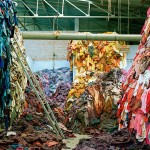Our Selfless World
There does not seem to be any definite end to life, if by ‘life’ we mean the capacity for continual change; and yet, we insist on looking far afield to where finality’s fabled horizon meets nothingness’ pitch-black silhouette, quite untouched by the life to which *we* are bound by still other strands of things living. This is clear from how the economic anthropology of the past five decades has let itself be defined by *travel ontogenies*. Ever since the publication of *The Social Life of Things* (1986), it has been near impossible to discuss value in anthropology without first making a detour through the crisscrossing life-threads of *travelling* objects, each to its own horizon. Appadurai and Kopytoff (1986) are able to talk in terms of such dualities because they follow on from Simmel in positing an emerging substantialism of ‘mutually constitutive forms’. From an antecedent multiplicity, individuality is somehow reposed in the agentive object; and so, that which in Marx had been so full of ‘life’ by virtue of mediating human activity and social relations, now finds itself demoted to an *automaton* – ostensibly self-operating but actually coded and programmed, and defined solely by a circulation of ideal states.
To centred agencies whose motion is expressed in terms of kinematic quantities with the aid of neatly organised units and points along striated planes, I contrast a *rolling fluid convection of itineraries* – such that affinities are generated at different scales from different social and material states. As with a strange attractor, the system never closes in on itself, however, meaning that no moment in time is ever repeated perfectly; and yet, the state of system remains. This helps explain how conditions of symmetry (stability) on the one hand, and flux (instability) on the other, despite ostensibly conflicting, appear to duly depend on and substantiate each other, within a common field of tension.
Nagarjuna deduced in his MMK that interdependence gives rise to phenomena that are indeterminate (*sunya*). Every concept that forms out of the concepts of something else is in itself empty. If every mode to which we assign a value is held in suspension by the fluid rolling convection of the many, then no-thing is affected by *a* thing. Whereas the *object* emerges from the convergence of fragments of a pre-emptive ‘whole’, as if driven by the disembodied spectre of some-thing that is yet to be born, the *thing* refers not to ‘itself’, the ‘ghost in the machine’, but to a particular scale of magnification from which to interpret the always unfolding synchronisation of itineraries.
Insofar as objects are cast in fixed forms, our world is decidedly a world without objects. Our world is the world of Spinoza rather, where things are defined, not by any immanent properties, but by the capacity to affect and be affected; a world that never relents the intensity of its motion but like a whirlwind exists *through* spin. It is the raison d’être of anthropology that the operative statements that constitute the semiological forms of interdependence, and that enter as itineraries into symmetries of practical activity, should be duly understood. We got to be attentive to the immanence in things, this diversifying impulse, their *élan vital* (cf. Bergson, 1911), according to which the whirlwind of social life settles in uncountable symmetries.
Understanding is something that needs liberating by ‘that attention which is so full that the “I” disappears’ (Weil 2002: 118), that attention which makes a *non-self* out of any-thing. Attention of such magnitude cannot immure itself in fixed forms outside its apprehension; it yields itself to the supreme sweep of its own demesne. It does not repose anything that does not belong to its antecedent multiplicity, whence its constituents are distinguished, not really, but modally; for what else but cadence itself appertains to a Nature in that welter of immanence? In our moving convection, sociality is neither laid over things nor imputed into them. We are instead confronted with a surge of social contingencies which substantiate sensation by mapping onto our activities, and which are substantiated in turn by having our activities be mapped onto them. This results in a process of recursion whereby *stuff* is designated as ‘things’ *in the invocation of another*.
Appadurai, A. (1986) The Social Life of Things, Cambridge: CUP
Bergson, H. (1911) Bergson Creative Evolution, London: Macmillan
Weil, S. (2002) Gravity and Grace, London: Routledge
Contributed by AdrianSjøvold on 07/02/2023






